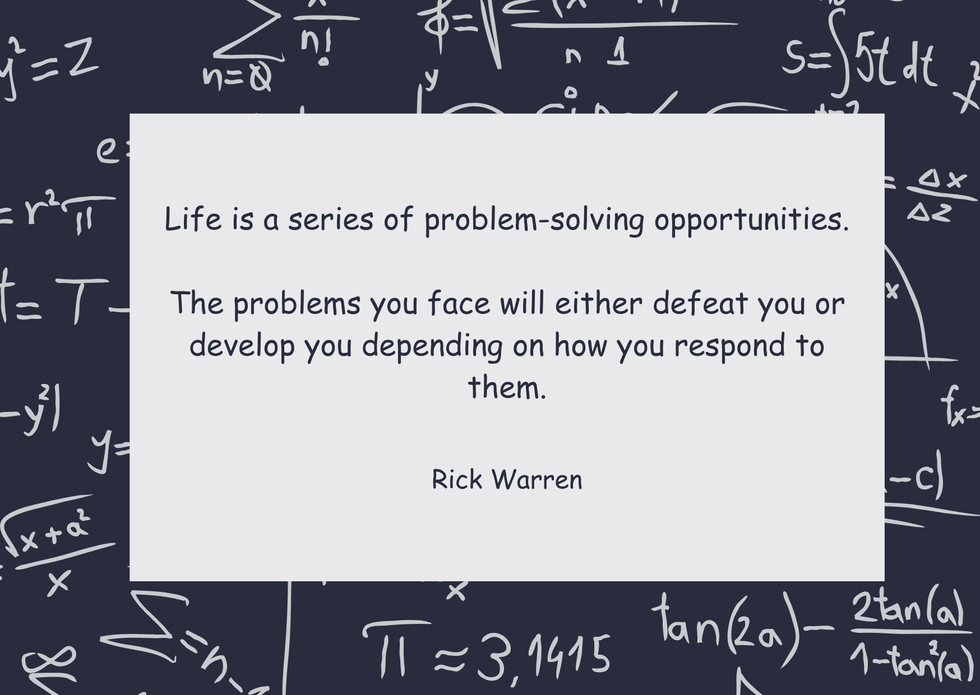Have you thought about how much problem-solving you typically do each day? If you don’t think very much, you may not be giving yourself enough credit.
Individuals typically solve numerous problems throughout the day for both personal and work. While many problems are solved consciously, you also engage in an unconscious problem-solving process throughout the day. These may involve automatic or instinctual responses to familiar situations as well as subconscious processing of information and experiences that influence decision-making. It could involve routine tasks, strategic decisions, and unexpected situations.
Problem-solving skills are essential because of their wide-ranging impact (and are listed as a required skill in many job descriptions). It fosters adaptability and resilience, enhances decision-making, enhances critical thinking and analytical skills, and drives innovation and creativity. So, learning from failures and adapting your approach based on feedback and new information is important.
There are several problem-solving techniques. Depending on the situation, some techniques will lend themselves and be more effective than other techniques. Some popular problem-solving techniques are brainstorming, PDCA (Plan-Do-Check-Act), and root cause analysis (RCA).
Different Problem-Solving Techniques

Image from Bigstock
Brainstorming is a creative technique that involves generating many ideas. It encourages individuals to generate ideas without judgment, potentially leading to innovative solutions. To generate a diverse collection of ideas, it’s crucial to have a diverse group of individuals with varied backgrounds, perspectives, expertise, and roles. Other considerations:
- Clearly articulate the problem you’re addressing and any specific goals or outcomes you hope to achieve,
- Establish ground rules to ensure productive and respectful participation,
- Capture and document ideas in real time using visual aids such as whiteboards or digital collaboration tools, and
- Summarize the key ideas generated and identify the next steps for further exploring, evaluating, or implementing promising ideas.
For example, if the organization wants to revamp its social media strategy utilizing gen AI, it may benefit from having a brainstorming session. Afterward, it may use the PDCA (Plan-Do-Check-Act) technique to see how well the implemented strategy is going.
The PDCA (Plan-Do-Check-Act) is a continuous improvement cycle used to address problems or make improvements systematically and iteratively. It involves planning a solution, implementing it, checking the results, and acting on the findings to further refine or adjust the solution. PDCA’s popularity stems from its simplicity, flexibility, and effectiveness in driving continuous improvement.
Root cause analysis (RCA) is used to identify the underlying root cause of a problem. It involves identifying the root causes (versus addressing its symptoms) responsible for a problem and then addressing those causes to prevent the problem from recurring. Some components of an RCA are:
- Identify the problem including its symptoms, observed effects, etc.,
- Analyze the impact quantifying the cost, risks, and implications associated with the problem,
- Identify the root cause including the primary and contributory root causes of the problem,
- Propose corrective actions and measures to prevent recurrence of the problem, and
- Remediate and monitor including timeliness, responsible parties, and performance metrics.
I like creating an RCA report after a system outage. It explains the 5 Ws—who, what, where, when, why—and how the outage occurred and to prevent it from happening again. It’s imperative to share the RCA report with your business partners.
Continuously Improving Your Problem-Solving Skills

Image created by Debra Shannon
Reflect on your problem-solving skills and commit to continuous improvement. If you want to improve your problem-solving abilities start by clearly defining the problem and practicing critical thinking and analysis. Do you have any experiences, insights, and perspectives on problem-solving to share?
For more information on the importance of having strong problem-solving skills, follow me on LinkedIn!
From Your Site Articles
Related Articles Around the Web
Source link
All Materials on this website/blog are only for Learning & Educational purposes. It is strictly recommended to buy the products from the original owner/publisher of these products. Our intention is not to infringe any copyright policy. If you are the copyright holder of any of the content uploaded on this site and don’t want it to be here. Instead of taking any other action, please contact us. Your complaint would be honored, and the highlighted content will be removed instantly.

